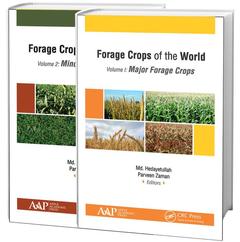Description
Forage Crops of the World, 2-volume set
Volume I: Major Forage Crops; Volume II: Minor Forage Crops
Coordinators: Hedayetullah Md., Zaman Parveen
Language: English
Subjects for Forage Crops of the World, 2-volume set:
· 15.2x22.9 cm · Hardback
Description
/li>Contents
/li>Biography
/li>
This new 2-volume set discusses the importance of fodder production of the minor fodder crops for animals. The volumes focuses on fodder production for forage crops, cover 17 major forage crops and 25 minor forage crops. The volumes discuss crop production methodology and agronomic management in a systemic way, providing an abundance of information on each type of forage crop discussed, including preferred soil type, land capability, cropping patterns, climate, and socioeconomic conditions. They also address pests of the various forage crops, disease management, agroforestry in fodder and forage crops, preservation of forage crops, and forage production and climate change.
Forage crops are very essential for quality milk and meat production. Farm animals are normally fed fodder available from cultivated areas, supplemented by a small extent with harvested grasses and top feeds. The three major sources of fodder are crop residues, cultivated fodder, and fodder from trees, pastures, and grazing lands. The patterns and types of fodder crops vary by geographical location.
Oat (Jai). Maize (Corn). Pearl Millet (Bajra). Sorghum (Jower). Johnson Grass (Aleppo Grass). Job’s Tears (Coix). Deenanath Grass (Pennisetum). Teosinte (Makchari). Sudan Grass (Sudan Sorghum). Hybrid Napier (Napier Bajra Hybrid). Guinea Grass (Green Panic Grass). Cowpea (Black Eyed Pea). Clusterbean (Guar). Rice Bean (Red Bean). Berseem (Egyptian Clover). Lucerne (Alfalfa). Stylo (Pencilflower). Pests of Leguminous Forages. Disease Management of Non Leguminous Seasonal Forages. Agro Forestry in Fodder and Forage Crops. Preservation of Forage Crops. Forage Production and Climate Change.
Md. Hedayetullah, PhD, is an Assistant Professor/Scientist and Officer In-Charge, AICRP (All India Coordinated Research Projects) on Chickpea, Directorate of Research, Bidhan Chandra Krishi Viswavidyalaya, Kalyani, Nadia, West Bengal. He is a former Agronomist with the NABARD, Balasore, Odisha, India. He was also formerly a Professor at the M.S. Swaminathan Institute of Agriculture Science, Centurion University of Technology and Management, Gajapati, Odisha, India, and an Assistant Professor at the College of Agriculture, Tripura, Government of Tripura, India. Dr. Hedayetullah is the author and co-author of 20 research papers, five review papers two book chapters, and one book.
Dr. Hedayetullah acquired his BS degree (Agriculture) from H.N.B. Garhwal University, UK, India. He received his MS degree (Agronomy) from Palli Siksha Bhavana, Institute of Agriculture, Visva Bharati University, Sriniketan, West Bengal, India. He received his PhD (Agronomy) from Bidhan Chandra Krishi Viswavidyalaya, Mohanpur, Nadia, West Bengal, India. He was awarded the Maulana Azad National Fellowship Award from the University Grant Commission, New Delhi, India. He has received several fellowship grants from various funding agencies to carry out his research works during his academic career.
Parveen Zaman, PhD, is an Assistant Director of Agriculture (Farm) at the Pulse & Oilseed Research Sub-Station, Beldanga, Department of Agriculture, Government of West Bengal, India. She is author and co-author of four research papers, three review papers, and four book chapters. She acquired her BS degree (Agriculture), receiving a Gold Medal, from Bidhan Chandra Krishi Viswavidyalaya, Mohanpur, Nadia, West Bengal, India. She received MS degree (Agronomy), also with Gold Medal, from Bidhan Chandra Krishi Viswavidyalaya, Mohanpur, Nadia, West Bengal, India. She was awarded the Maulana Azad National Fellowship Award from the University Grants Commission, New D




